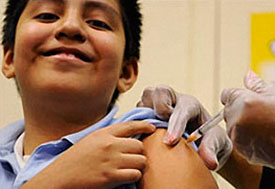Lessons learned from history's influenza pandemics
September / October 2011 | Volume 10, Issue 5

Photo by Yuri Kozyrev/World Bank
Health officials should remain vigilant in the wake
of the 2009 flu pandemic, according to an analysis
of historical data published as a
special supplement
of
Vaccine, edited by Fogarty scientists.
Past influenza pandemics have much to teach today’s scientists about future outbreaks. An examination of historical influenza pandemics is the subject of a
supplement to the journal
Vaccine, which is guest edited by Fogarty scientists Drs. Mark A. Miller and Cecile Viboud, Vikash Parekh and Dr. Gerardo Chowell of Arizona State University.
Articles range from examinations of the regional impacts of the 1918 influenza pandemic around the world, to analyses of the effects of the 2009 H1N1 flu outbreak, to the downside of using annual all-cause mortality data to estimate the pandemic influenza burden.
In the lead article, the guest editors discuss the need for interdisciplinary studies of historic pandemics. “The 2009 H1N1 pandemic sharpened our focus on past pandemics: How can we use lessons learned from historic pandemics to better understand the epidemiology of the 2009 pandemic virus and guide the public health response to recurrent waves?” the authors ask. “Historic pandemics have repeatedly demonstrated that emerging viruses follow a pattern of returning in several recrudescent waves, in some cases with the heaviest mortality burden occurring several years after the virus first emerged.”
Although the WHO has declared the 2009 pandemic over, the authors caution that it’s “not yet time to let down our guard.” They conclude that mortality impact will occur over several years. “It is therefore critical to maintain surveillance efforts and international data sharing in the post-pandemic period so that prevention and control programs can be tailored to the changing epidemiology of post-pandemic influenza,” the authors write.
The genesis for the publication was an international gathering of biomedical and social scientists that convened in May 2010 in Copenhagen to discuss research methodologies and findings from data associated with historic influenza pandemics.
More Information
To view Adobe PDF files,
download current, free accessible plug-ins from Adobe's website.